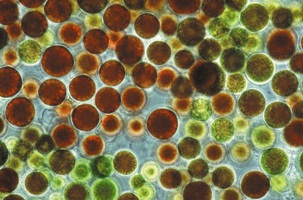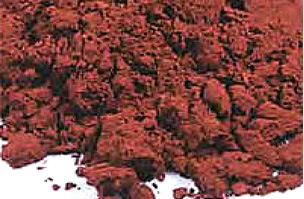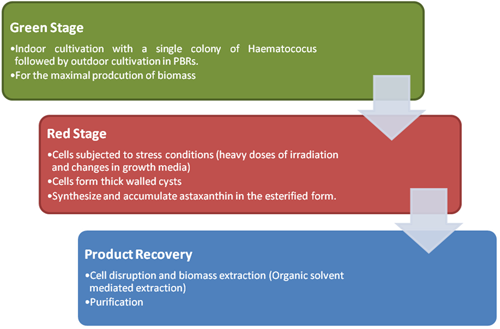Astaxanthin
This section provides inputs on the following aspects of
Astaxanthin
- What is Astaxanthin?
- Source of Astaxanthin
- Benefits of Astaxanthin
- Applications of Astaxanthin
- Strains that Produce Astaxanthin
- Market Scope of Astaxanthin
- Prominent Players
- Challenges in Astaxanthin Production
- Astaxanthin – Factoids
|
Astaxanthin is a naturally occurring high-value ketocarotenoid pigment with excellent antioxidant effects Astaxanthin is present in many types of seafood, including salmon, trout, red sea bream, shrimp and lobster, as well as in birds such as flamingo and quail. As of today, astaxanthin is commercially produced from the microalga: Hematococcus pluvialis. The global astaxanthin market is estimated at about $257 million, most of which is used in fish coloration (2009 data; estimates by BCC Research for astaxanthin market size are however lower). The human uses market is growing and estimated at about $27-$40 million. Astaxanthin is principally consumed by the salmon feed industry. Professor Sammy Boussiba of the Microalgal Biotechnology Laboratory in the Ben Gurion University of Negev has developed the biotechnology of producing astaxanthin-rich Haematococcus pluvialis biomass. Commercial production of astaxanthin is being carried out in USA, India, Japan and Israel Research shows that due to astaxanthin's potent antioxidant activity, it may be beneficial in cardiovascular, immune, inflammatory and neurodegenerative diseases Although natural sources have long been exploited for astaxanthin production, it is still uncertain if natural astaxanthin can be produced at lower cost than that of synthetic astaxanthin or not. One of the major limitations with the H pluvialis production system is that the astaxanthin gets trapped behind thick cells walls, thus complicating the extraction process and the production yields. |
What is Astaxanthin?
Astaxanthin is a naturally occurring high-value ketocarotenoid pigment with excellent antioxidant effects belonging to the xanthophyll group of carotenoids, or the oxygenated carotenoids. The hydroxyl and keto functional groups present in the ending ionone ring of astaxanthin is responsible for its uniquely powerful antioxidant activity. They differs from other antioxidants in its ability to penetrate the blood brain and retina barriers. Therefore, it is believed to protect the brain and nervous system from neurodegenerative diseases (e.g. cerebral thrombosis and stroke) and aging.
Natural astaxanthin production and commercialization is estimated to be a 1.2 billion dollar annual market. Today, essentially all commercial astaxanthin for aquaculture is produced synthetically from petrochemical sources, with an annual turnover of over $200 million, and a selling price of around $2000 per kilogram of pure astaxanthin. Natural astaxanthin is sold for over $7000 per kg.
Business Opportunities & Market Size of Astaxanthin
Read More @ Comprehensive Report on Attractive Algae Product Opportunities.
Source of Astaxanthin
Astaxanthin is present in many types of seafood, including salmon, trout, red sea bream, shrimp and lobster, as well as in birds such as flamingo and quail. As of today, astaxanthin is commercially produced from the microalga Hematococcus pluvialis.
Benefits of Astaxanthin
- Astaxanthin acts as a chain-breaking anti-oxidant, and therefore protect lipid-rich cell membranes from degradative oxidation.
- Natural astaxanthin is a dietary supplement with extremely powerful antioxidant benefits for human applications.
- Astaxanthin traps more free radicals than any other antioxidant.
- Astaxanthin has been proven to cross the human blood-brain barrier, and therefore has the ability to directly act as a superb antioxidant in the brain and the eyes.
- Astaxanthin enhances the action of other antioxidants like Vitamin E and C.
- Astaxanthin protects nucleic acid components of DNA, avoiding mutations to genetic material due to oxidative stress and protects muscle cells from damaging effects of active oxygen produced upon swimming upstream.
- Astaxanthin has been documented to prevent age-related macular degeneration (AMD) and enhance immune functions.
Applications of Astaxanthin
- Astaxanthin finds application in the nutraceutical Industry, pharmaceutical Industry and food coloration application
- Astaxanthin is used as an animal feed additive to impart coloration to salmonids (salmon and trout), as well as to red sea bream and Tai.
- Recent studies revealed the wrinkling and moisturizing effect of astaxanthin which suggest its potential cosmeceutical applications in protection against skin aging.
Algae Strains for Astaxanthin Production
Business Opportunities & Market Size of Astaxanthin
Read More @ Comprehensive Report on Attractive Algae Product Opportunities.
The most commonly used algae strain that is used for Astaxanthin production is Haemotococcus Pluvalis. H pluvialis is believed to accumulate the highest levels of astaxanthin in nature. Commercially grown H pluvialis can accumulate more than 40g of astaxanthin per kilogram of dry biomass. Other strains that could be used for astaxanthin production include: Chlorella vulgaris, Chlorella zofingiensis, Coelastrella striolata var. multistriata

Haematocyst of Haemotococcus pluvialis with red pigment astaxanthin.

Astaxanthin
Commerical Production of Astaxathin
Natural astaxanthin is produced in a two-stage culture process and its concentration can reach 1.5% to 4% of the dry weight.

Market Scope
The demand for natural astaxanthin is now emerging in the multi-billion dollar nutraceutical market. Astaxanthin is principally consumed by the salmon feed industry. The annual worldwide aquaculture market of this pigment is estimated at US$ 200 million with an average price of US$ 2500/kg.
The global astaxanthin market is estimated at about $257 million, most of which is used in fish coloration (2009 data; estimates by BCC Research for astaxanthin market size are however lower). The human uses market is growing and estimated at about $27-$40 million. Most astaxanthin is derived from the algae, H pluvialis, which is commonly consumed by fish and crustaceans – like salmon and lobster – and is responsible for their pink coloration.
Market Sectors | Market Size ( as of 2009) ( Million USD) | Potential Market(2020) ( Million USD) |
Animal feed colouring agents | 300 | 800 |
Antioxidant nutraceuticals | 30 | 300 |
Pharmaceuticals | Emerging | 500 |
Cosmetics | Emerging | 30 |
Table: Market Sectors and Future Market Potential of Astaxanthin
Prominent Players in the Astaxanthin Market
Company | Location |
Alga Technologies | Israel |
Cyanotech | Hawaii |
Jingzhou Natural Astaxanthin Inc | China |
Algaetech International | Malaysia |
Parry Nutraceuticals | India |
Mera Pharmaceuticals Inc., | Hawaii
|
Fuji Chemicals | Japan, Sweden |
Valensa International | Florida |
University and Research Efforts | |
Arizona State University – Recently developed a harvesting system for Astaxanthin production from Hematococcus combining acidification and dissolved air flotation. This system is capable of harvesting more than 95% of the biomass without the need for a coagulant or flocculent, and extracting over 95% of the intracellular astaxanthin from Haematococcus biomass. | Ben-Gurion University of Negev Professor Sammy Boussiba of the Microalgal Biotechnology Laboratory in the Ben Gurion University of Negev has developed the biotechnology of producing astaxanthin-rich Haematococcus pluvialis biomass.
|
Challenges in Astaxanthin Production
- Although natural sources have long been exploited for astaxanthin production, it is still uncertain if natural astaxanthin can be produced at lower cost than that of synthetic astaxanthin or not.
- One of the major limitations with the H pluvialis production system is that the astaxanthin gets trapped behind thick cells walls, thus complicating the extraction process and the production yields.
- Production capacity of H pluvialis is constrained by its intrinsic slow growth, low cell yield, ease of contamination by bacteria and protozoa, and susceptibility to adverse weather conditions. These challenges are magnified as processes are scaled up, and therefore require advanced technology to control
H pluvialis cannot be efficiently cultivated in dark heterotrophic mode, which requires high levels of irradiance, making the process economically less reasonable.
Astaxanthin - Factoids
- One of the technical challenges to developing Haematococcus algae astaxanthin has been the tough cell wall of the spores, which must be ruptured to allow the cell contents to be effectively digested by animals. Cyanotech Corporation in Hawaii uses a combination of closed photobioreactors and open culture ponds to successfully mass produce astaxanthin-rich Haematococcus biomass, and proprietary milling technology to crack the cell walls.
- Commercial production of astaxanthin is being carried out in USA, India, Japan and Israel
- Astaxanthin is a carotenoid. Astaxanthin has been shown in studies to have 100-500 times the antioxidant capacity of Vitamin E as well as 10 times beta-carotene’s antioxidant capacity. Astaxanthin is found in many places in nature, but it is usually in small quantities as in salmon or shrimp.
- By far the most concentrated and natural source of astaxanthin is the Haematococcus pluvialis algae. These green algae also provide other important carotenoids such as beta-carotene. It accumulate the highest levels of astaxanthin in nature; commercially more than 40g of astaxanthin per kilo of dry biomass.
- Research shows that due to astaxanthin's potent antioxidant activity, it may be beneficial in cardiovascular, immune, inflammatory and neurodegenerative diseases. Some sources have demonstrated its potential as an anti-cancer agent. Research supports the assumption that it protects body tissues from oxidative damage. It also crosses the blood-brain barrier, which makes it available to the eye, brain and central nervous system to alleviate oxidative stress that contributes to ocular, and neurodegenerative diseases such as glaucoma and Alzheimer's.
- Astaxanthin, as other carotenoids, can act as a quencher of singlet oxygen and other free radicals by absorbing the excited energy of singlet oxygen onto the polyene electron-rich chain, resulting first in the excitation of the carotenoid to a triplet state, and then in the dissipation of the extra energy in the form of heat by relaxation back to the ground state. In this way, it prevents cellular components or tissues from being damaged. The carotenoid structure remains unchanged, and ready to act as a radical quencher.
- Astaxanthin has been shown to protect against free radicals and promote numerous health functions. Astaxanthin offers protection against a broad range of human diseases like neuro-degenerative disorders. The antioxidant of astaxanthin is stronger than β-carotene and vitamin E by 40x and 1,000x respectively.
Related Links
|
Click Here to Know More |
|
|
Poly unsaturated fatty acids(DHA,ARA,GAL and EPA) Aquaculture Feed (Shrimp feed, Shellfish Feed, Marine Fish Larve cultivation ) |
|

